Search results
Author(s):
Didier Tchétché
,
Chiara de Biase
,
Bruno Brochado
,
et al
Added:
3 years ago
Sixteen years have elapsed since the first transcatheter aortic valve implantation (TAVI) and the procedure has now been widely adopted. The first time the procedure was performed, the patient was under conscious sedation with local anaesthesia for an antegrade-transseptal procedure.1 The pioneering team in Rouen published a series of case reports for patients treated via a transfemoral route…
View more
Author(s):
Simon Kennon
,
Zhan Lim
Added:
3 years ago
The main advantages of transcatheter aortic valve implantation (TAVI) over conventional aortic valve replacement (cAVR) surgery are the avoidance of sternotomy, heart lung bypass and prolonged procedure times. These advantages facilitate early mobilisation and discharge – important both clinically and in terms of resource utilisation. Balanced against this, TAVI is less predictable than cAVR –…
View more
KR Julian Chun
Research Area(s) / Expertise:
Job title: Proffessor
Author
Author(s):
Jean-François Paul
Added:
3 years ago
In the clinical management of patients with complex congenital heart disease (CHD), accurate 3D evaluation of their morphological conditions is critical. 3D imaging should demonstrate the shape and spatial relation of great arteries, proximal branch pulmonary arteries and anomalous pulmonary venous or systemic connections, and eventually coronary artery course. 3D information on extra-cardiac…
View more
Author(s):
Kully Sandhu
,
Rob Butler
,
James Nolan
Added:
3 years ago
Percutaneous revascularisation has become the cornerstone of ischaemic heart disease management.1,2 Historically, coronary angiography and intervention was predominantly performed via the common femoral artery.3 However, this procedure has an associated 1.5–9.0 % risk of complications, most of which are related to bleeding at the femoral access site.4 Despite a significant reduction in the…
View more
Author(s):
Pavel Overtchouk
,
Thomas Modine
Added:
3 years ago
This article aims to provide an updated comparative review, addressing the respective strengths and weaknesses of different alternative transcatheter aortic valve implantation (TAVI) approaches.
The transfemoral (TF) access is favoured by international guidelines on TAVI because of its reported superiority to the transthoracic approach.1–3 In spite of the progress in miniaturisation of new…
View more
Author(s):
Kendra J Grubb
Added:
1 year ago
Dr Kendra Grubb (Emory Structural Heart and Valve Center, GA, US) outlines the interim analysis of the Optimize PRO Study (NCT04091048), originally presented at EuroPCR 2022.
Optimize PRO aimed to evaluate valve performance and procedural outcomes of optimised TAVR care using Medtronic's Evolut™ PRO and Evolut™ PRO+ devices.
Findings are promising and show that no patients experienced a…
View more
Overcoming the Challenges of the Transfemoral Approach in Transcatheter Aortic Valve Implantation
Author(s):
Stephane Noble
,
Marco Roffi
Added:
3 years ago
Article















